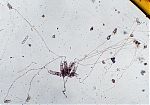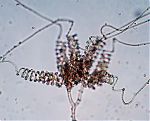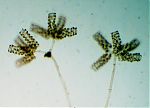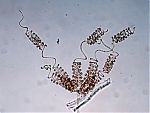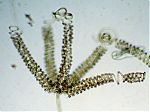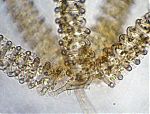Spirodactylon
SPIRODACTYLON R.K. Benjamin, 1959 (Aliso 4:408); 1 sp. (Benjamin, 1959).
Sporangiophores septate, simple or branched, fertile region coiled. Sporocladia produced at the apex of the sporangiophore and at maturity arises from the side, and on the inside of the coil, of the fertile region as the tip grows. Sporocladium multicelled, producing pseudophialides from the lower surface. Merosporangia unicelled, broadly ellipsoid, one produced from each pseudophialide; released dry at maturity. Zygospores more or less globose; suspensor hyphae undifferentiated, formed in the substrate hyphae.
Type species: S. aureum
Species of Spirodactylon:
S. aureum R.K. Benjamin, 1959 (Aliso 4:408) (Young 1968).
Spirodacylon aureum is a beautiful fungus that has been collected only from dung. The fungus is yellow and because of it color it is observed easily amoung the other fungi growing with it. Growth is poor in culture, even when grown on YGCH agar (O’Donnell et al., 1998). The presence of contaminating fungi in the culture often promote growth and sporulation of S. aureus. The spores of S. aureus are ornamented with spines. (Young, 1968). O’Donnell (1979) has published SEM photographs of S. aureus.
Bibliography
Benjamin, R.K. 1959. The merosporangiferous Mucorales. Aliso 4:321-433.
O’Donnell, K.L. 1979. Zygomycetes in Culture. Palfrey Contributions in Botany No. 2. Department of Botany, University of Georgia, Athens, Georgia.
O’Donnell, K, E. Cigelnik, and G.L. Benny. 1998. Phylogenetic relationships among the Harpellales and Kickxellales. Mycologia 90:624-639.
Young, T.W.K. 1968. Electron microscopic study of the asexual structures in Kickxellaceae. New Phytologist 67:823-836.
Updated Sep 23, 2008

